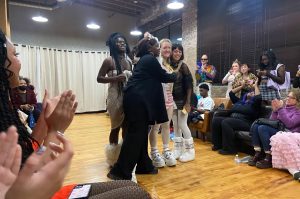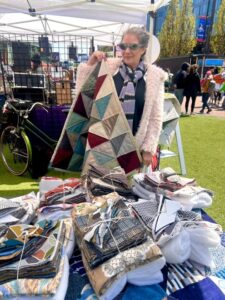The terms fashion and sustainability have intertwined in recent years due to the ease and popularity of fast fashion. However, according to designer Adilah Muhammad, the root of creating fashion is not entirely sustainable.
“If you’re creating a clothing brand, you’re not really on the side of sustainability,” said Muhammad, a Chicago fashion designer who specializes in ethically produced, small-batch fashion. “It’s not sustainable for anybody to make more clothes in this world, where we could all stop and the world would be just fine with all the clothes that we have.”
However, fashion is an ever-changing form of personal expression for consumers, and it is how designers make a living. Producing ethical clothes and repurposing vintage garments are popular forms of sustainable production, but fast fashion is affecting sustainability efforts.
Fast fashion includes clothing that is created quickly and marketed cheaply to consumers. It is related to generating high levels of CO2, creating 92 million tons of garment waste and producing half a million tons of microplastics, according to the not-for-profit environmental organization Earth.org.
Brands are working towards promoting a healthier fashion cycle through sustainable and ethical production to help lower the weight fast fashion has on the environment.
Muhammad said that her method of production is to not overproduce. “The max is three or four pieces per size. And that would be if I go over, which means I’m selling in a few places.”
By limiting excess stock to lower the production of unneeded garments, as well as creating items at an affordable price for her customers, Muhammad has gained revenue from those that are passionate about sustainability.
She recommends creating a theme for your designs that allow consumers to be loyal and respect your brand.
“If you’re somebody who’s like, ‘I just do custom pieces and make one-of-ones because I am making something that someone is going to treasure,’ it’s completely different from a big box brand, where that is not their mission. Their mission is to make money,” Muhammad said.
In a study by Kirsi Niinimäki from 2015, they found that consumers value brands that take action on sustainability and “consider the consequences of design and industrial manufacturing.” Niinimäki is an associate professor in design at Aalto University in Finland, where she focuses on fashion research and the future of textiles.
Mintel, a market research agency, recommends fashion brands highlight values over price, which can make consumers feel they are choosing “’cheaper’ choices for positive reasons,” like sustainable small designers.
As well, other values include having consumers’ “deep inner needs” met. This can be done by collaborating with consumers to “[co-produce] value in a closed loop industrial system where all materials, even old clothes, are valuable raw material for the industrial system,” Niinimäki’s study said.
The Shudio (shop and studio) in Pilsen, owned by Merl Kinzie, capitalizes on this by selling vintage garments. Their focus is on eco-friendly and conscious consumerism.
Through the difficult process of curating vintage garments, such as carefully cleaning and mending items, Kinzie has found that when thrifting, “you are seeing a lot more of modern fast fashion that you’re paging through to find that hidden gem.”
“There are a lot of barriers and limitations towards being sustainable. It’s not only inaccessible for a lot of people from a price standpoint,” Kinzie said. “There’s also a lot of size inclusivity issues in a lot of brands.”
However, small retailers and designers are facing direct issues with fast fashion brands because of stolen designs. Muhammad has seen this firsthand.
“I’ve seen designers who have worked really hard on things, and maybe their price point is a little higher. Then, because of fast fashion companies having funds and manpower, they will rip off the designs and make it really cheap,” Muhammad said. In July 2021, this had occurred as designer Elyon Adede posted on Twitter that a garment they worked on was copied by Shein, with no consent from the designer.
Muhammad discussed what life used to be like before fast fashion existed, where going to your local tailor or asking your grandma to fix a garment was more inclusive. “We don’t have that because fast fashion has literally killed it. Because of fast fashion, there’s no sense of community,” she said.




















Be First to Comment